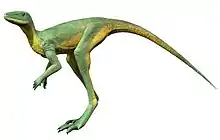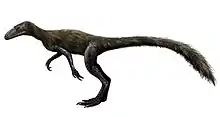Dinosauriformes
Dinosauriformes is a clade of archosaurian reptiles that include the dinosaurs and their most immediate relatives. All dinosauriforms are distinguished by several features, such as shortened forelimbs and a partially to fully perforated acetabulum, the hole in the hip socket traditionally used to define dinosaurs. The oldest known dinosauriform is Asilisaurus, a silesaurid which may have lived as early as the Anisian age of the middle Triassic period, about 245 million years ago.[2]
| Dinosauriforms | |
|---|---|
 | |
| Mounted skeleton of Marasuchus, an early dinosauriform which may be synonymous with Lagosuchus.[1] | |
| Scientific classification | |
| Kingdom: | Animalia |
| Phylum: | Chordata |
| Clade: | Dinosauromorpha |
| Clade: | Dinosauriformes Novas, 1992 |
| Subgroups | |
Definition
Dinosauriformes was coined in 1992 by F.E. Novas, who used it to encompass dinosaurs, Lagosuchus, "Pseudolagosuchus", and the herrerasaurids, which he did not consider to be "eudinosaurs" (true dinosaurs like ornithischians and saurischians).[3] Contrary to Novas, most paleontologists since 1992 have considered herrerasaurids to be true dinosaurs, though many other primitive, dinosaur-like reptiles still fall within his definition of Dinosauriformes. Dinosauriformes lies within a slightly larger clade, Dinosauromorpha, which corresponds to all reptiles closer to dinosaurs than to pterosaurs.[4]
Novas (1992) defined Dinosauriformes as a node-based clade containing the most recent common ancestor of Lagosuchus and Dinosauria, and all its descendants.[3] Nesbitt (2011) provided a roughly equivalent definition, using Marasuchus and Passer domesticus (the house sparrow, a representative of dinosaurs). In his analysis, Dinosauriformes included dinosaurs, silesaurids, and Marasuchus, but not lagerpetids, which were considered a more primitive family of dinosauromorphs.[4]
Phylogeny
Cladogram simplified after Nesbitt et al. (2010) with the terminology of Cau (2018):[5]
| Dinosauriformes |
| ||||||||||||||||||||||||
References
- Agnolin, Federico L.; Ezcurra, Martin D. (2019). "The Validity of Lagosuchus Talampayensis Romer, 1971 (Archosauria, Dinosauriformes), from the Late Triassic of Argentina" (PDF). Breviora. 565 (1): 1–21. doi:10.3099/0006-9698-565.1.1. ISSN 0006-9698. S2CID 201949710.
- Nesbitt, S.J.; Sidor, C.A.; Irmis, R.B.; Angielczyk, K.D.; Smith, R.M.H.; Tsuji, L.M.A. (2010). "Ecologically distinct dinosaurian sister group shows early diversification of Ornithodira". Nature. 464 (7285): 95–98. doi:10.1038/nature08718. PMID 20203608. S2CID 4344048.
- Novas, Fernando E. (January 1992). "Phylogenetic relationships of basal dinosaurs, the Herrerasauridae" (PDF). Palaeontology. 35 (1): 51–62.
- Nesbitt, S.J. (2011). "The early evolution of archosaurs: relationships and the origin of major clades" (PDF). Bulletin of the American Museum of Natural History. 352: 1–292. doi:10.1206/352.1. hdl:2246/6112. S2CID 83493714.
- Andrea Cau (2018). "The assembly of the avian body plan: a 160-million-year long process" (PDF). Bollettino della Società Paleontologica Italiana. 57 (1): 1–25. doi:10.4435/BSPI.2018.01.
Sources
- Ezcurra, M.D. (2006). "A review of the systematic position of the dinosauriform archosaur Eucoelophysis baldwini Sullivan & Lucas, 1999 from the Upper Triassic of New Mexico", USA. Geodiversitas, 28 (4): 649-684.
- Hutchinson, J.R. & Gatesy, S.M. (2000). "Adductors, abductors, and the evolution of archosaur locomotion". Paleobiology 26 (4): 734-751
- Novas, F.E. (1996). "Dinosaur Monophyly". Journal of Vertebrate Paleontology 16 (4): 723-741.
- Sereno, P.C. and Arcucci, A.B. (1994). "Dinosaur precursors from the Middle Triassic of Argentina: Lagerpeton chanarensis". Journal of Vertebrate Paleontology 13: 385-399.



